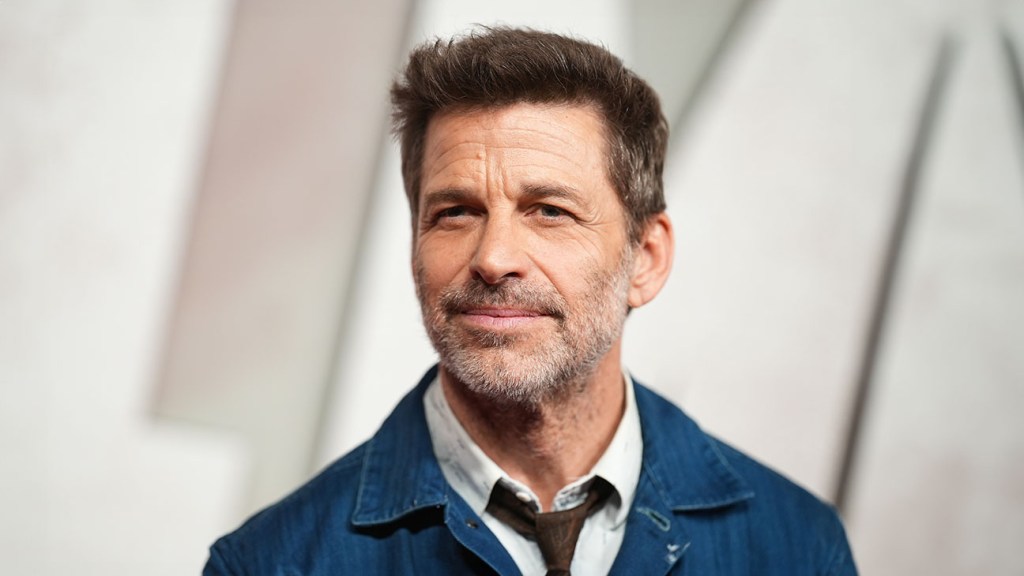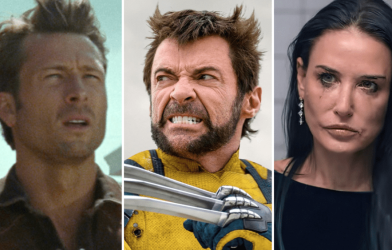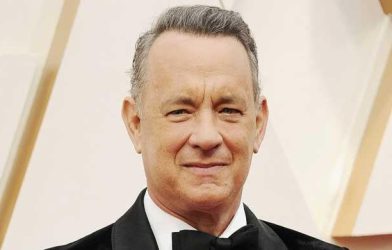
Zack Snyder
John Nacion/Getty Images
[The following story contains spoilers for Rebel Moon — Part Two: The Scargiver.]
Zack Snyder knows the intricate future of his Rebel Moon universe, and now it’s up to the audience to make sure that Netflix leadership feels the demand to bring as many as four more movies to fruition.
Between today’s release of Rebel Moon — Part Two: The Scargiver and this summer’s R-rated director’s cuts of Part One and Two, Netflix subscribers will have plenty of opportunities to impose their will on the streamer, but currently, the situation is up in the air now that Snyder is caught up in an all-too-familiar regime change. Gone is the director’s longtime collaborator Scott Stuber, and with Dan Lin now taking the reins from Stuber as Netflix’s new film chief, it’s anyone’s guess as to how things will unfold.
“As they do their reshuffling, I’m just not sure what they intend. We 100 percent know where the movies go and everything, and I’m excited for everyone to check out Part Two,” Snyder tells The Hollywood Reporter. “I’m also excited for everyone to get to go on this alternative reality director’s cut journey, which is my catharsis. But … it’ll be fun to see where we go after that.”
Venturing into spoiler territory, Part Two leaves Kora (Sofia Boutella) and the rest of the surviving rebels in a rather tantalizing place, as the powerful Princess Issa is still alive. So the potential third installment will involve Kora and company tracking her down, while also seeking allies from surrounding planets now that there’s a blueprint for taking down Imperium dreadnoughts.
“The story of movie three would be tracking [Princess Issa] down and finding out how [the rebels] can use the victory at Veldt to create a coalition of planets that were on the edge of rebellion, but have now seen the example of downing a dreadnought. Maybe now there’s an opportunity. It’s a chink in the armor. That’s really what it is,” Snyder says.
Netflix originally asked Snyder to make PG-13 cuts of both his Rebel Moon films so that younger teenagers could watch without Netflix parental controls serving as a barrier. Historically, PG-13 films also present more merchandising opportunities. But, in exchange, he was given complete creative freedom to make two R-rated director’s cuts, and he’s champing at the bit for the audience to see his original vision.
“The director’s cuts really are the alternate universe version of these movies. They’re what I wrote. They’re much more mythological and much more tonally weird and much more the deconstructivist quality of the sci-fi universe that I intended,” Snyder admits. “I really wanted to make a movie that was much more Heavy Metal magazine than Star Wars, and much more irreverent than reverent. The PG-13 version is much more earnest. It’s weirdly earnest because you don’t have over-the-top sex and violence to set a tone. The [director’s cuts] are both three hours long with tons of scenes that you’ve never seen and just tons of other crazy stuff, as well as a very significant R rating that is not a joke.”
Before the rebels and Veldt villagers squared off in battle against Admiral Noble’s (Ed Skrein) army in Part Two’s epic second hour, there’s a 12-minute sequence where the rebel heroes trade war stories. This Last Supper-esque sequence was actually inspired by a sequence in Snyder’s planned sequel to Zack Snyder’s Justice League.
“There absolutely is a Last Supper in Justice League 2, and the scene had them telling the stories of how they got there, because Justice League 2 was going to open with us now 10 years in the future,” Snyder shares. “And yes, [Rebel Moon — Part Two’s sequence] has a similar sort of structure to the Justice League 2 scene that we have.”
Below, during a recent spoiler conversation with THR, Snyder also explains why certain rebels didn’t survive the Veldt battle, before offering his reaction to Christopher Nolan’s recent comment about his influence throughout the sci-fi and superhero genres.
Zack, that second hour is something else. [Writer’s Note: I started the interview a bit too soon, as Snyder was sending word to Deborah Snyder to purchase Civil War tickets.]
Thank you! I appreciate that.

Rebel Moon — Part Two: The Scargiver. From left: Doona Bae as Nemesis, Staz Nair as Tarak, Michiel Huisman as Gunnar, Sofia Boutella as Kora, Elise Duffy as Milius and Djimon Hounsou as General Titus.
Netflix
Well, the first hour certainly laid the groundwork for the thrilling second hour, and there’s a Last Supper-type sequence where the rebels trade war stories. This was originally going to be a sequence in Justice League Part II, right?
There absolutely is a Last Supper in Justice League 2, and the scene had them telling the stories of how they got there, because Justice League 2 was going to open with us now 10 years in the future. “How did we get here?” So that was kind of it, and yes, [Rebel Moon — Part Two’s sequence] has a similar sort of structure to the Justice League 2 scene that we have.
Of all those potential DC movies you outlined, would you say that you smuggled 10 percent of those ideas into Rebel Moon?
Yeah, there’s a couple. There’s a fair number in there, I guess, but certainly not enough to make a Justice League 2 movie not viable.

Rebel Moon — Part Two: The Scargiver: Fra Fee as Balisarius.
Netflix
Getting into Rebel Moon — Part Two spoilers, Kora (Sofia Boutella) told Gunnar (Michiel Huisman) about the events that led her to flee the Imperium. So, of all the people he could have turned into a patsy, why did Balisarius (Fra Fee) choose his adopted daughter? Why blame her for the assassination of the royal family?
He values nothing. He sees the kings as rotatable, but the style and the heart of the Motherworld must continue, so he would sacrifice anything for it. Kora is also in the perfect position to take the fall for the whole thing. I don’t think he sees it as necessarily a betrayal, because they’re both soldiers, and the idea of sacrificing for the Motherworld is the thing that they’d both been taught from an early age. If he talked to her, he would say, “You were given this honor to sacrifice yourself for the royal family, to continue the line, and you selfishly ran.” So that’s how he would probably take it.
We eventually learn that Princess Issa can resurrect more than just birds, as she’s still alive. Does that also help explain why we haven’t seen Balisarius outside of the astral plane in present day? Are they holed up somewhere together?
Balisarius is back on the Motherworld, and Issa is somewhere else in hiding. They have this thing called the Order of 12, which are the 12 original Jimmies that protected the royal family, and they were all destroyed, except for one called Bartholomew. So [Issa and Bartholomew] are probably hiding somewhere in the universe. The story of movie three would be tracking her down and finding out how they can use the victory at Veldt to create a coalition of planets that were on the edge of rebellion, but have now seen the example of downing a dreadnought. Maybe now there’s an opportunity. It’s a chink in the armor. That’s really what it is.

From left: Rhian Rees as The Queen, Cary Elwes as The King, Sofia Boutella as Kora and Stella Grace Fitzgerald as Princess Issa in Rebel Moon — Part Two: The Scargiver.
Clay Enos/Netflix
For the royal family assassination scene, did Tom Holkenborg compose that string piece for the musicians to play on the day?
Yeah, that piece was composed.
It’s gorgeous.
Yeah, it’s amazing. It really works amazing. So we hired this group of musicians. They didn’t play it [on the day], but we had it playing on set.
Besides Noble’s (Ed Skrein) decapitated head, what can we expect from the director’s cuts?
Well, the director’s cuts really are the alternate universe version of these movies. They’re what I wrote. They’re much more mythological and much more tonally weird and much more the deconstructivist quality of the sci-fi universe that I intended. I really wanted to make a movie that was much more Heavy Metal magazine than Star Wars, and much more irreverent than reverent. The PG-13 version is much more earnest. It’s weirdly earnest because you don’t have over-the-top sex and violence to set a tone. You are stuck in this dour … it is fun and the action is exciting, but the people have to express in this middle zone. So the fun of the director’s cuts is the hour of additional footage in each of the films. The films are both three hours long with tons of scenes that you’ve never seen and just tons of other crazy stuff, as well as a very significant R rating that is not a joke. But it really fills out the mythology in a great way.
With Noble now gone, does Balisarius have another lunatic admiral type waiting in the wings?
I feel like we’re going to get a lot more of Balisarius himself as you go forward. If you were to make the rest of the stories that I have laid out, you’d certainly have a Balisarius percentage increase. Exponentially, you’d start getting more and more Balisarius until it’s just Balisarius and Kora, probably.

Michiel Huisman as Gunnar and Sofia Boutella as Kora in Rebel Moon — Part Two: The Scargiver.
Netflix
Kora has now lost two lovers in battle, and she cries, “Why can’t I have this one thing?” So why couldn’t she have this go her way this time?
As far as love goes and loving and the why of loving, Gunnar is probably the first lover she’d had that was transcendent of war. This lover was outside of the conflict, and he was just a guy, really. Gunnar is a good guy, but he’s just a guy. He’s not necessarily a soldier or a leader, and it’s a stepping stone for her. She’s on this journey of catharsis as well, obviously, and Gunnar’s sacrifice is part of that journey.
Besides Gunnar (Michiel Huisman), Nemesis (Doona Bae) also met her end after protecting the Veldt women and children. Considering all the options, why was this the right time for her to go?
Nemesis, of all the rebels, fixes what she needs to fix in herself.
Are you still leaving the door open on Darrian Bloodaxe’s (Ray Fisher) fate?
It could be [open]. It’s hard to say. That’s a question mark.

Jimmy in Rebel Moon — Part Two: The Scargiver.
Netflix
Ever since the first teaser, I’ve been anxiously awaiting that firefly shot of Jimmy. Has it been difficult to hold that back?
Yeah, that’s in the director’s cut. There’s a really great little sequence with him and the fireflies. Jimmy, in the director’s cut, goes through this long cathartic journey where he finds his cape, his horns, and he inspects the growth of the wheat. He watches them fix Kora’s dropship and maybe helps out. He sees Sam [Charlotte Maggi] and Aris [Sky Yang] working in the fields. So he’s got an eye on everybody, and he’s really quite present. There’s also a little bit more of our relationship to Veldt. We see the crops growing. So, yes, it was difficult to hold it back, but we really were shooting for that two-hour window or very close to it. So some things had to go, as they say.
When Kora re-hides her dropship in Part Two, that startling waterfall reveal of Jimmy was also really well done.
Yeah, I knew that Jimmy had been keeping an eye on the villagers, and Kora’s dropship is a big reveal. It’s a big piece of the puzzle for them. So he would’ve noticed that Kora was going to hide it, and I knew that that’s where they would have their little conversation about the why of the both of them. “You and I are alike, designed to kill for them.” It’s that idea.
So to bring Jimmy into that sequence, I’d been working on this shot where we discovered Jimmy against the waterfall. It’s two shots: the reveal and then what she sees. But it worked out great. She’s scared, but then you see her relax because she knows it’s like an old friend in a weird way. She’s never fought with this Jimmy, but she has fought with other ones. So she’s comfortable with Jimmies, and she understands the way they think.
Netflix is doing a lot of reshuffling right now, so what can you say at this stage regarding Part Three?
As they do their reshuffling, I’m just not sure what they intend. We 100 percent know where the movies go and everything, and I’m excited for everyone to check out Part Two. I’m also excited for everyone to get to go on this alternative reality director’s cut journey, which is my catharsis. It was amazingly fun to do. But now that you’re four hours into the Rebel Moon universe, with another potential six hours coming for you, it’ll be fun to see where we go after that.

Sofia Boutella as Kora in Rebel Moon — Part Two: The Scargiver.
Netflix
You’ve served as your own DP on your last three films. Has that job changed anything about the way you direct when compared to your days with your longtime DP Larry Fong?
Don’t get me wrong, I loved my days with Larry, and I wouldn’t trade them for the world. But I was a director-cameraman in the commercial world for 10 years, and it was kind of the way I normally worked. So [being the DP] doesn’t change the way I [work], but the main thing is that I’m just much more present from moment to moment. I have to be. When you’re just directing, there’s time for self-reflection. As they’re lighting, there’s time to think about the way the scene is going to go and stuff. And in the current working conditions, I’m 100 percent in all the way, all the time, and there’s no resting or thinking. You have to be very prepared. It’s difficult to shoot a movie, and I thank God I have John Clothier, my camera operator. I operated the second camera and did plenty of operating. So it’s an exhaustive and difficult thing, but I really love doing it. I love lighting and it’s super fun.
Chris Nolan paid you quite a compliment not too long ago, saying, “There’s no superhero science-fiction film coming out these days where I don’t see some influence of Zack.” I know you’re friends, but did that high praise still bowl you over?
It’s too much! (Laughs.) No, it was nice. I hold him in the highest regard, and he’s an amazing filmmaker, obviously. I don’t need to tell you that. He loves movies. He’s a real student of film as well, and so, coming from him, it’s really incredibly kind.

Director-writer-producer Zack Snyder and producer Deborah Snyder on the set of Rebel Moon.
Clay Enos/Netflix
Chris turned a profit on Interstellar’s corn. Were you able to sell Rebel Moon’s wheat and grain?
We didn’t earn a profit, but we did use the grain. A lot of the cattle on the farm where we grew our wheat were fed with our grain, and we also drank some beer that was made from it. (Laughs.)
When Tom Holkenborg first emailed you that transcendent Flash theme for the climactic sequence in Zack Snyder’s Justice League where Barry winds back the clock, could you immediately sense that you’d struck gold with that cue?
Tom is such an incredibly talented composer, and with that sequence in particular, it’s one of those things where, in some ways, the music disappeared. It was also the most obvious thing at the same time, because it fits so perfectly into the sequence. It was like the sequence didn’t exist before I saw it with that music on it, and then you were like, “Oh, there it is!” So one of Tom’s gifts is that he really knows how to make it live, and there are very few guys out there that can do that.
For whatever reason, I didn’t catch Sucker Punch until a handful of years ago, and I remember thinking, “Oh, that’s why Zack keeps rehiring Jena Malone,” as she’s quite good in the movie. You still have unfinished business with that one?
Absolutely. The extended version is not really a director’s cut, but it’s 18 minutes longer and much better than the theatrical version. But there’s another version that I would say is really the movie-movie.
Decades from now, when your family asks you about the making of Rebel Moon, what day will you likely tell them about first?
It’d be a lot of the scenes in the longhouse, weirdly, with all the sci-fi weirdness. I remember very vividly — as if it was happening right now — Charlotte [Maggi] handing the banners out to everyone and all the dancing. The way we built the set, it was completely immersive. If you went out the front door, you’re in Veldt. It’s everywhere. You can’t get away from it. And for a lot of those scenes, we’d look out the door, so we’d hide all the equipment and everything. So those were really special nights where we would all be hanging out and laughing and filming these scenes. It was like summer camp.
***
Rebel Moon — Part Two: The Scargiver is now streaming on Netflix.









